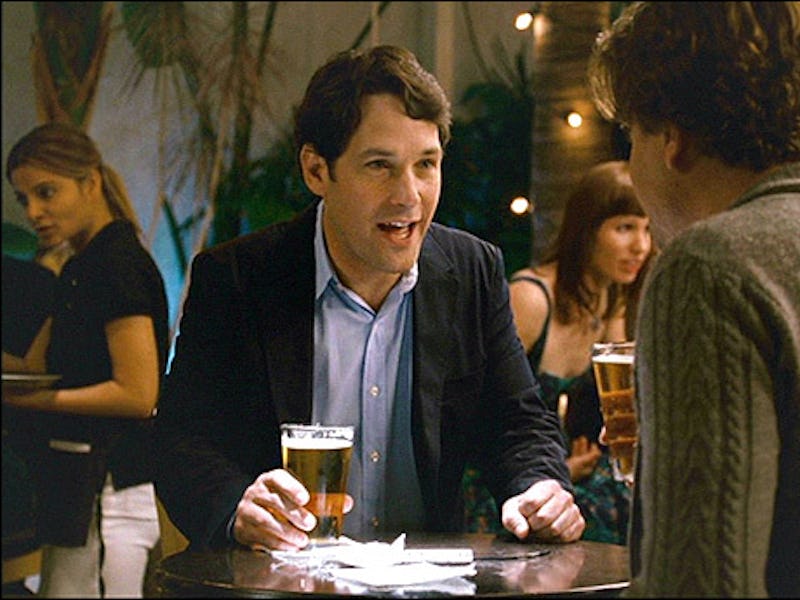On any given night in any given bar, at least one thing is certain: Drunk people will be horny. But to whom all that sexual energy will be directed toward isn’t always clear. Recently, scientists conducted a small study that suggested that heterosexual people became more curious about gay sex as they got drunker. Their study isn’t definitive, but it does ask us to reconsider the nature of drunken horniness.
To study this, the researchers went straight to the action, heading to a bar-filled neighborhood in an unnamed midwestern American town to recruit drinkers stumbling around outside between 10 p.m. and 1 a.m. In the paper they published in The Journal of Social Psychology in April, they describe the details of their “field study,” which involved first finding 83 participants and asking them how many drinks they’d had that night and their sexual orientation. Then, each recruit watched videos of attractive people hanging out alone at the bar, chatting with the bartender. After watching, each person was asked a series of questions about what they were willing to do, romantically and sexually, with the person in the video.
There was no guarantee, however, that the person in the video would match up with the participants’ stated gender preference.
Some straight men watched an attractive woman at the bar, while others saw a video that featured an attractive man. The same applied to female participants. (The study was limited to cisgender people.) In this way, the researchers from Wayne State University and Western Illinois University were able to test how people’s “sexual willingness” toward same-sex and other-sex partners changed in relation to how many drinks they’d had.
The first few questions were relatively innocuous: Would you buy the person in the video a drink? Would you buy them more than one? But they got racier as the series went on, culminating in the inevitable: Would you have sex with this person?
Some of the results came as no surprise — straight men were generally more sexually interested in women, straight women were more interested in videos with men, and men were more sexually interested in general. But the most notable results had to do with same-sex situations.
It turns out straight men grew more willing to entertain the idea of a homosexual hookup as they got drunker. While their willingness to have sex with a woman didn’t change with the number of drinks they had (that is, they were equally DTF with women whether they were sober or drunk), their willingness to have sex with a man did. “Most notably, alcohol intake was related to increased sexual willingness of men with a same-sex partner, suggesting a potential shift in normative casual sexual behavior among heterosexual men,” the researchers write. In other words, straight men who’d had up to ten drinks were roughly as interested in men as they were in women.
The findings were slightly different for women, whose willingness to have sex with both men and women increased with the amount of drinks they’d had.
The authors conclude that “alcohol consumption may lead people to engage in sexual behavior that is incongruent with their self-reported sexual identity.” And in this study, they add, “this was especially true of men.”
In 'I Love You, Man,' a heterosexual male relationship toes the line of homosexual romance with a nudge from alcohol.
They admit they can’t say for sure why this happens, but they offer up two speculative explanations. The first is obvious: Alcohol lowers our inhibitions. It’s entirely possible, they write, that a straight person’s hesitation about hooking up with a person of the same sex is one of the inhibitions that booze melts away.
Their second is less predictable — and especially timely. These days, the researchers point out, “it is possible that contemporary culture may foster and even support incongruent sexual behavior,” and they suggest that the results of this study might not have looked the same had it been carried out in a different decade.
While we’ve got a long way to go before society completely accepts the full spectrum of gender preferences, we’ve come a long way from the days of total heteronormativity, and that relaxation of social rules might explain why people are more willing to consider exploring the world outside their stated gender preferences. The researchers point out Katy Perry’s same-sex innuendos on “I Kissed a Girl,” together with Kevin Spacey’s occasional hookups with men on House of Cards, to illustrate this point. Women, they’re careful to note, appear to receive more encouragement to hook up with other women — but they also write that “erotic plasticity is evident in men as well, and it may be on the rise.”
These days, shows like the CW’s teen drama Riverdale make it a point to portray gender fluidity without judgment. In a world like that, a study like this one probably wouldn’t even happen — labels like “straight” and “gay” would soon be obsolete — but for now, scientists must make do with exploring what it’ll take for society to get there.
Abstract:
Sex is ubiquitous in the media but only a fraction depicts sexual interactions between same-sex partners. This field study, conducted outside of bars in the Midwestern United States, examined 83 heterosexuals’ sexual willingness with a same- or other-sex partner. Participants viewed a randomly assigned video vignette of a same- or other-sex partner. Alcohol intake, partner attractiveness, and sexual willingness were measured. Using moderated regression analysis, we found that alcohol intake predicted sexual willingness with the male target for both men and women, but not with the female target. The attractiveness of same-sex partners was related to sexual willingness. Sexual willingness was only influenced by alcohol intake and perceived attractiveness of a same-sex prospective partner. Most notably, alcohol intake was related to increased sexual willingness of men with a same-sex partner, suggesting a potential shift in normative casual sexual behavior among heterosexual men.
